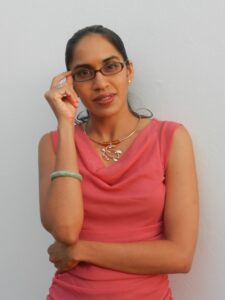Adana Mahase-Gibson was the project manager of the first regional One Health project in the Caribbean (‘One Health One Caribbean One Love’, OACPS-implemented and EU-funded) in which Chandra Degia was actively involved. This professional partnership has resulted in a solid, long-term friendship that has recently led to the creation of the Caribbean One Health Alliance, a network of senior One Health Caribbean professionals, of which Adana is the co-chair. Adana is from Trinidad and Tobago, with a background in veterinary and humanities. Chandra is from Jamaica, with a background in environmental management and environmental education. Both have long experience in sustainable development, addressing issues such as climate change, food security, poverty reduction, racism and sexism. And both are passionate about community empowerment, women in STEM, equity, diversity and inclusion. They express in this interview their strong convictions about their One Health approach, and the role of women, indigenous knowledge holders and artists in finding solutions and getting messages across.
Could you remind us in a few words what is the One Health approach?
|
Adana Mahase-Gibson |
One Health means focusing on the interdependent health of humans, animals and our shared environment. In a nutshell, One Health is an approach to complexity. And connected problems require connected solutions. Therefore, when we are looking at global challenges from a macro level, things like climate change, and on the micro-level, with things like anti-microbial resistance, there isn’t a recipe to follow or a blueprint to make a machine to magically solve it. Because it’s complex, and there are interdependencies, sometimes solving one aspect may create other problems. One Health for us means being comfortable with uncertainty, which is never easy to do. |
Going back to the Caribbean, what are the most specific One Health challenges to address in this region?
Adana: The Caribbean region faces climate change- like the rest of the world, but also food insecurity, increasing natural disasters like hurricanes, exploding volcanoes, micro-plastics, emerging and reemerging diseases. Our list is quite long. However, for us to grasp any of these challenges, we believe it lies deeper. It is our inability for collective action. We struggle to work together to change at a systemic level.
Why ? For funding reasons. Lack of time? Lack of willingness?
Adana: Challenges like climate change, for example, require skills in managing people from multiple perspectives, at different scales, rather than technical expertise in any particular field. So, by training, we are focused explicitly on technical expertise, but we need to be explicit about how to get things done by relationship building. During our Caribbean One Health leadership series, for example, participants identified leadership and HR skills as significant benefits that made a positive impact on their professional life. This is not how we currently operate. Colonialism, racism and sexism for us play out in real-time and gatekeepers continue to guard power and value systems fiercely. We work in heavily entrenched, siloed systems that are resistant to change. While we can dabble here and there, systemic change means embracing our history of genocide, slavery, indentureship and oppression. And to understand who we are and how we got here, and how we can work with allies to achieve systemic change.
And is it that kind of systemic approach which justifies the emergence of the Caribbean One Health Alliance? How did it come about?
|
Chandra Degia |
It came about, through the network of Caribbean One Health professionals, built across the region during the previous One Health One Caribbean One Love project One Health. We collaborated with each other within the region, and not as it was usually the case with researchers or professionals from Europe or North America. Even though the project ended, and there was no more funding, we still kept in touch. We call on each other to share available resources, information, data and success stories from some of our countries. Then one day Adana approached me and said, ‘Hey, what if we formalize this?’ And here we are today in 2022 with the Caribbean One Health Alliance. |
What is its added value, compared to other active One Health networks in the region?
Adana: In the Caribbean, the other active networks are mostly academic and research-oriented. Major funding and projects have been funneled through these small but influential networks. It has created an imbalance in stakeholders’ representations, and therefore narrower perspectives to address One Health issues. We want to work together to ensure that our stories and the data coming out of the Caribbean are led by Caribbean voices and not interpreted by non-Caribbean professionals, because it has led to misrepresentation of our experiences and culture.
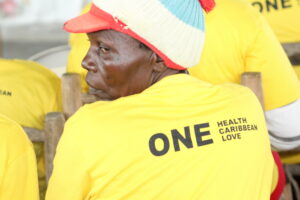
(Haiti’s pesticide reduction project)
On the occasion of International Women’s Day 2022, your alliance honoured about twenty women from the region, as female trailblazers working to implement One Health-related solutions. Is your alliance a female-only organisation? Or a mixed one?
Adana: We realize that Caribbean One Health women are at the forefront working on many of these complex challenges, but they go unnoticed. It was a great opportunity to highlight these trailblazers. We are not a female-only organization. However, we do believe that gender equality is the only way forward, and we are aiming to be gender transformative leaders. We want to smash those stereotypes of men being natural leaders and females being too emotional to lead. More female leaders means there are more role models and mentors for future generations
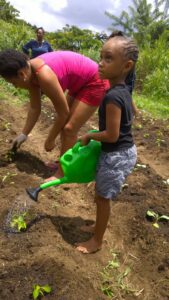
(Addressing iron deficiency Anaemia through improved nutrition in Dominica)
Do women have specific assets that can help accelerate the implementation of One Health solutions?
Adana: Even if you just set aside the justice of it, if you ignore 50% of your population, you are unlikely to have an effective response. We have lots of evidence of this from past efforts. Diverse decision-making groups represent lived experiences and diverse groups make better decisions, especially when women share knowledge and experience at the leadership table in equal numbers with men.
The Caribbean One Health Alliance is one of the few organizations willing to talk about race, equity, gender and diversity in the region. Why is it taboo and how will you make a difference?
Chandra: These issues are not just taboo in the Caribbean, but across the world, because it’s hard to face our own prejudices and issues of mental slavery. We want to think that we are all wonderful human beings, but the truth is that we are entrenched in a system that is built on colonialism, and we’re still facing neo-colonialism today. As Adana mentioned, we also face gender bias. If we truly want to have diversity, equality and equity, then we have to face these difficult issues head-on. It is going to make some people uncomfortable for a while, but with persistence, we believe that over time, we will see improvements and we will make strides.
How will it be translated concretely?
Chandra: For example, we had some discussions about working with underrepresented communities, like the Maroons. We have in these communities very powerful women who are not in formal leadership positions. We want to implement projects where women are empowered, but also where, when we have persons who are skilled and trained in our region, we are not forced to take technical people from other countries, who don’t understand our social and cultural context.
Adana: What may work in, let’s just say in the United Kingdom or Canada, for example, cannot be replicated here. Values and systems are different, and it is really important to understand where we have come from, and how different cultures have been shaped over centuries. Each island is different. What worked in Jamaica or Trinidad can crash and burn in Saint Vincent and the Grenadines, for example. We must actively listen and try to figure out culturally appropriate methods for each situation because ‘one size does not fit all’. A helpful guiding principle for us is the practice of ‘two-eyed seeing’* for intercultural collaboration.
Indigenous people know a lot about the interconnections between humans, animals, plants, ecosystems and their shared environment. How this indigenous knowledge could be better taken into account and combined with modern science?
Chandra : We, as scientists, need to put our egos aside and be a little bit more humble and open. As a practitioner of environmental management for 30 years, I have found oftentimes that local knowledge and indigenous knowledge are key to project failure or success. You know, you have your scientific data, and then you go out into the field and it’s a different scenario. And there may be persons in that local or indigenous community, whether it’s a maroon community or another community saying to you, don’t go here, because, at this point, the river is going to widen or at 10:00 in the day, this stream disappears or whatever. And you pay that person no mind because you have the scientific data that tells you otherwise. And when you go there, exactly what that person said has happened. We need to respect local and indigenous knowledge because even in the Caribbean, a lot of now so-called wonder plants and herbs have been known to local and indigenous people. They may not tell the name of the active chemical compound, but they know that if you boil or dry this plant and put it on your wound, it will heal in two days without any side effects. As a scientist who was once a skeptic of all things that were not provable, I think my life experiences have shown me that there is more to this world than scientific facts and data. If you are open to the teachings and knowledge of local and indigenous persons, you will learn a lot and you will actually improve the implementation of solutions in communities.
Adana: I would like to add that we have to get better at respecting and also collecting oral traditions, because indigenous knowledge is usually based on oral traditions. And we tend to not pay attention or value it as much because it’s not written. We have to get better at active listening.
My last question is for you, Chandra: under the previous One Health One Caribbean One Love project, you worked closely with popular entertainers to develop key engaging messages. What is the power of art in terms of environmental education or even science communication?
Chandra: We worked with the famous reggae artist Bay-C, One Health’s Celebrity Patron. Music is one art form that is extremely powerful, especially in the Caribbean, where we are so tied historically, and culturally through our African and Indian roots to music. It is in our blood, in our bones, and a part of our culture and being. And we found that one of the best ways to communicate with many of our target audiences was through music, especially children, who learn more easily if they are taught in song because they learn melody first. Art, whether it is music, the performing arts, painting, whatever, is very important in science communication and environmental education, because scientists speak in jargon, a quite dry and boring language that the average person doesn’t understand. And what we know about environmental education is that one of the strongest predictors of responsible environmental behavior is environmental sensitivity, which is empathy for the environment. It’s not an intellectual factor. It’s an emotional factor, something that marketers tap into. We are emotional beings and we have to get people to connect on an emotional level. And using art, I believe, is an important way to do so.
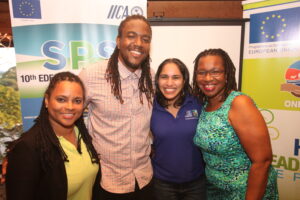
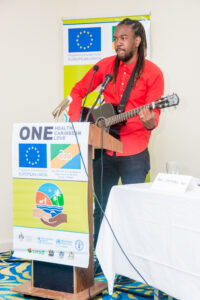
(Caribbean One Health Family – Platinum selling artiste, Bay-C, Chandra, Adana and Professor Alafia Samuels)
Watch the video of Bay-C’ ListenMi News: https://www.youtube.com/watch?v=0mL29J_J_bk
*Two-Eyed Seeing is an approach of inquiry and solutions in which people come together to view the world through an Indigenous lens with one eye (perspective), while the other eye sees through a Western lens
